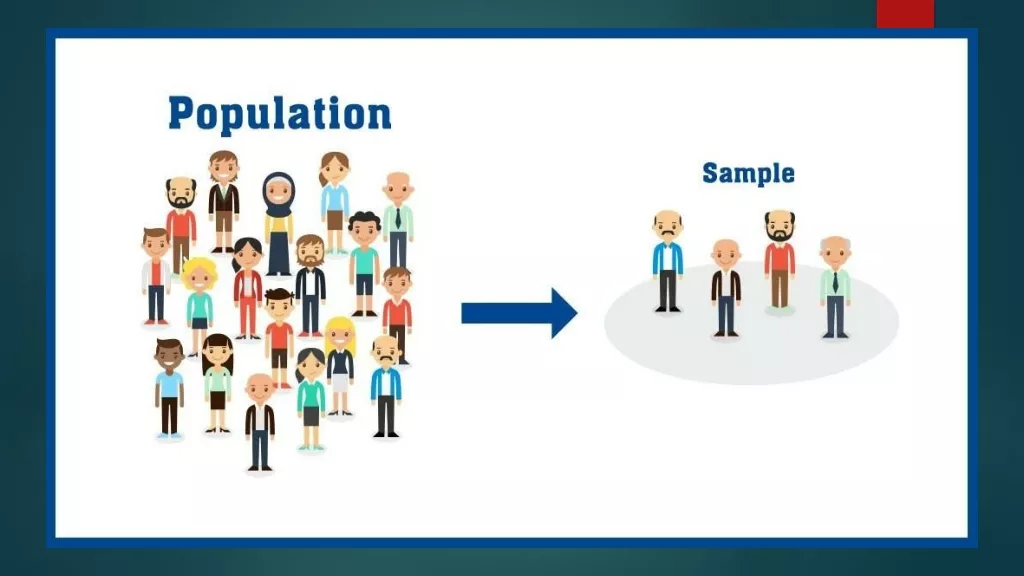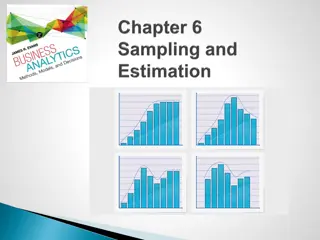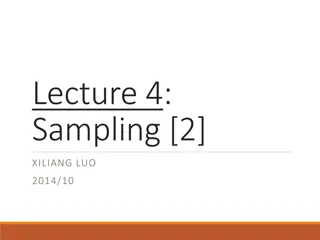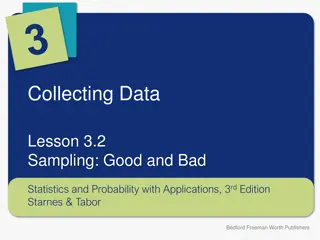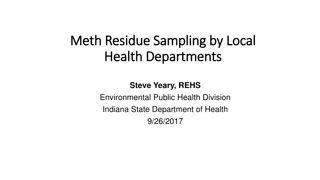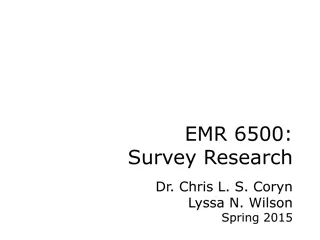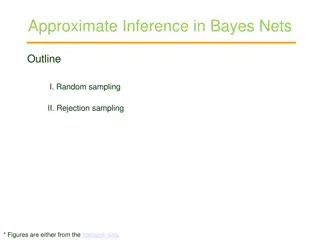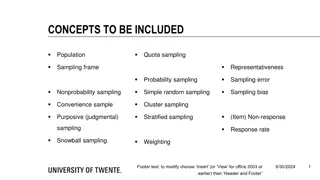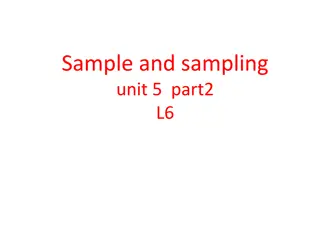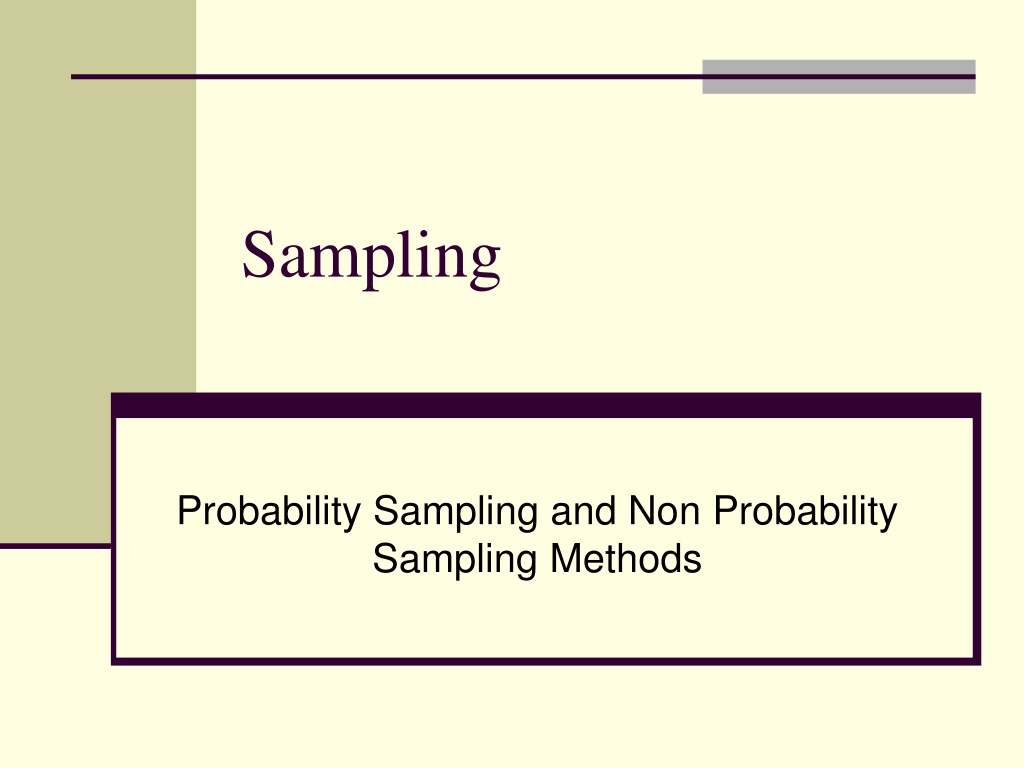
Understanding Sampling Methods in Research
Explore the importance of sampling in research, from drawing individual cases to studying populations efficiently. Learn about probability and non-probability sampling methods, sampling frames, and target populations. Discover how sampling helps researchers gather valuable insights while saving time and costs.
Download Presentation

Please find below an Image/Link to download the presentation.
The content on the website is provided AS IS for your information and personal use only. It may not be sold, licensed, or shared on other websites without obtaining consent from the author. If you encounter any issues during the download, it is possible that the publisher has removed the file from their server.
You are allowed to download the files provided on this website for personal or commercial use, subject to the condition that they are used lawfully. All files are the property of their respective owners.
The content on the website is provided AS IS for your information and personal use only. It may not be sold, licensed, or shared on other websites without obtaining consent from the author.
E N D
Presentation Transcript
Sampling Probability Sampling and Non Probability Sampling Methods
Introduction Sampling The process of drawing a number of individual cases from a larger population A way to learn about a larger population by obtaining information from a subset of a larger population Example Presidential polls are based upon samples of the population that might vote in an election
Introduction Why Sample? To learn something about a large group without having to study every member of that group Time and cost Studying every single instance of a thing is impractical or too expensive Example Census
4 SAMPLING BREAKDOWN
Introduction Why Sample? We want to minimize the number of things we examine or maximize the quality of our examination of those things we do examine.
SAMPLING. STUDY POPULATION SAMPLE TARGET POPULATION 6
Introduction Why Sample? Population The group of elements from which a researcher samples and to which she or he might like to generalize
Population definition A population can be defined as including all people or items with the characteristic one wishes to understand. Because there is very rarely enough time or money to gather information from everyone or everything in a population, the goal becomes finding a representative sample (or subset) of that population. 8
Introduction Why Sample? Sample A number of individual cases drawn from a larger population
Introduction Sampling Frames, Probability versus Nonprobability Samples Target population A population of theoretical interest
PROBABILITY SAMPLING A probability sampling scheme is one in which every unit in the population has a chance (greater than zero) of being selected in the sample, and this probability can be accurately determined. 11
Introduction Sampling Frames, Probability versus Nonprobability Samples Sampling frame or study population The group of elements from which a sample is actually selected
NON PROBABILITY SAMPLING Any sampling method where some elements of population have no chance of selection (these are sometimes referred to as 'out of coverage'/'undercovered'), or where the probability of selection can't be accurately determined. Example: We visit every household in a given street, and interview the first person to answer the door. In any household with more than one occupant, this is a nonprobability sample, because some people are more likely to answer the door (e.g. an unemployed person who spends most of their time at home is more likely to answer than an employed housemate who might be at work when the interviewer calls) and it's not practical to calculate these probabilities. 13
Introduction Sampling Frames, Probability versus Nonprobability Samples Nonprobability Samples A sample that has been drawn in a way that doesn t give every member of the population a known chance of being selected
Introduction Sampling Frames, Probability versus Nonprobability Samples Probability A sample drawn in a way to give every member of the population a known (nonzero) chance of inclusion Probability samples are usually more representative than nonprobability samples of the populations from which they are drawn
Introduction Sampling Frames, Probability versus Nonprobability Samples Biased Samples A sample that is not representative from the population which it is drawn Probability samples are LESS likely to be biased samples
Introduction Sampling Frames, Probability versus Nonprobability Samples Generalizability The ability to apply the results of a study to groups or situations beyond those actually studied A probability sample tends to be more generalizable because it increases the chances that samples are representative of the populations from which they are drawn.
Sources of Error Associated with Sampling Sampling Error Any difference between the characteristics of a sample and the characteristics of the population from which the sample is drawn
Types of Probability Sampling Simple Random Sampling Systematic Sampling Stratified Sampling Cluster Sampling Multistage Sampling
Types of Probability Sampling Simple Random Sampling A probability sample in which every member of a study population has been given an equal chance of selection One way to draw a simple random sample, is to put all possibilities on paper, cut them up, and then draw a sample from a hat Research Randomizer (http://randomizer.org)
Types of Probability Sampling Systematic Sampling A probability sampling procedure that involves selecting every kth element from a list of population elements, after the first element has been randomly selected Example Divide the total number of elements by the number you want in your sample 24/6 = 4 Randomly select a number between 1 and 4 and then select every 4th element from that number
SIMPLE RANDOM SAMPLING Applicable when population is small, homogeneous & readily available All subsets of the frame are given an equal probability. Each element of the frame thus has an equal probability of selection. It provides for greatest number of possible samples. This is done by assigning a number to each unit in the sampling frame. A table of random number or lottery system is used to determine which units are to be selected. 22
Types of Probability Sampling Systematic Sampling Selection interval The distance between the elements selected in a sample Selection Interval (k) = population size sample size
Types of Probability Sampling Stratified Sampling A probability sampling procedure that involves dividing the population in groups or strata defined by the presence of certain characteristics and then random sampling from each stratum Example If you had a population that was 10% women and you want a sample that is also 10% women
SYSTEMATIC SAMPLING Systematic sampling relies on arranging the target population according to some ordering scheme and then selecting elements at regular intervals through that ordered list. Systematic sampling involves a random start and then proceeds with the selection of every kth element from then onwards. In this case, k=(population size/sample size). 25
Types of Probability Sampling Stratified Sampling Steps to draw a stratified random sample Group the study population into strata or into groups that share a given characteristic Randomly sample within each strata 1. 2.
Types of Probability Sampling Cluster Sampling A probability sampling procedure that involves randomly selecting clusters of elements from a population and subsequently selecting every element in each selected cluster for inclusion in the sample Cluster sampling is an option if data collection involves visits to sites that are far apart
STRATIFIED SAMPLING Finally, since each stratum is treated as an independent population, different sampling approaches can be applied to different strata. Drawbacks to using stratified sampling. First, sampling frame of entire population has to be prepared separately for each stratum Second, when examining multiple criteria, stratifying variables may be related to some, but not to others, further complicating the design, and potentially reducing the utility of the strata. Finally, in some cases (such as designs with a large number of strata, or those with a specified minimum sample size per group), stratified sampling can potentially require a larger sample than would other methods 28
STRATIFIED SAMPLING. Draw a sample from each stratum 29
Types of Probability Sampling Cluster Sampling Example You are conducting a study of Kentucky high school students You could obtain a list of all high school students in the state and complete random sampling A cluster sample would be more practical Obtain a list of all high schools in Kentucky Random sample the high schools from the list Obtain a list of students for each high school selected and then contact each of those students
Types of Probability Sampling Multistage Sampling A probability sampling procedure that involves several stages, such as randomly selecting clusters from a population, then randomly selecting elements from each of the clusters
CLUSTER SAMPLING Cluster sampling is an example of 'two-stage sampling' . First stage a sample of areas is chosen; Second stage a sample of respondents within those areas is selected. Population divided into clusters of homogeneous units, usually based on geographical contiguity. Sampling units are groups rather than individuals. A sample of such clusters is then selected. All units from the selected clusters are studied. 32
Types of Nonprobabilty Sampling Purposive Sampling Quota Sampling Snowball Sampling Convenience Sampling
Types of Nonprobability Sampling Purposive Sampling A nonprobability sampling procedure that involves selecting elements based on a researcher's judgment about which elements will facilitate his or her investigation
Types of Nonprobability Sampling Quota Sampling A nonprobability sampling procedure that involves describing the target population in terms of what are thought to be relevant criteria and then selecting sample elements to represent the relevant subgroups in proportion to their presence in the target population
Types of Nonprobability Sampling Snowball Sampling A nonprobability sampling procedure that involves using members of the group of interest to identify other members of the group
Types of Nonprobability Sampling Convenience Sampling A nonprobability sampling procedure that involves selecting elements that are readily accessible to the researcher Sometimes called an available-subjects sample

